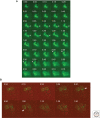Chemical gradients and chemotropism in yeast
- PMID: 20066086
- PMCID: PMC2742094
- DOI: 10.1101/cshperspect.a001958
Chemical gradients and chemotropism in yeast
Abstract
Chemical gradients of peptide mating pheromones are necessary for directional growth, which is critical for yeast mating. These gradients are generated by cell-type specific secretion or export and specific degradation in receiving cells. Spatial information is sensed by dedicated seven-transmembrane G-protein coupled receptors and yeast cells are able to detect extremely small differences in ligand concentration across their approximately 5-microm cell surface. Here, I will discuss our current knowledge of how cells detect and respond to such shallow chemical gradients and in particular what is known about the proteins that are involved in directional growth and the establishment of the polarity axis during yeast mating.
Figures




Similar articles
-
Polarization of the yeast pheromone receptor requires its internalization but not actin-dependent secretion.Mol Biol Cell. 2010 May 15;21(10):1737-52. doi: 10.1091/mbc.e09-08-0706. Epub 2010 Mar 24. Mol Biol Cell. 2010. PMID: 20335504 Free PMC article.
-
Chemotropism during yeast mating.Methods Mol Biol. 2009;571:99-110. doi: 10.1007/978-1-60761-198-1_6. Methods Mol Biol. 2009. PMID: 19763961
-
The role of Far1p in linking the heterotrimeric G protein to polarity establishment proteins during yeast mating.Science. 1998 Nov 20;282(5393):1511-6. doi: 10.1126/science.282.5393.1511. Science. 1998. PMID: 9822386
-
Pheromone response in yeast.Trends Biochem Sci. 1990 Jul;15(7):270-3. doi: 10.1016/0968-0004(90)90052-d. Trends Biochem Sci. 1990. PMID: 2116688 Review.
-
Pheromone signaling pathways in yeast.Sci STKE. 2006 Dec 5;2006(364):cm6. doi: 10.1126/stke.3642006cm6. Sci STKE. 2006. PMID: 17148787 Review.
Cited by
-
Mating yeast cells use an intrinsic polarity site to assemble a pheromone-gradient tracking machine.J Cell Biol. 2019 Nov 4;218(11):3730-3752. doi: 10.1083/jcb.201901155. Epub 2019 Sep 30. J Cell Biol. 2019. PMID: 31570500 Free PMC article.
-
Chemotropism among populations of yeast cells with spatiotemporal resolution in a biofabricated microfluidic platform.Biomicrofluidics. 2020 Jan 17;14(1):014108. doi: 10.1063/1.5128739. eCollection 2020 Jan. Biomicrofluidics. 2020. PMID: 32002107 Free PMC article.
-
Secretion of Polypeptide Crystals from Tetrahymena thermophila Secretory Organelles (Mucocysts) Depends on Processing by a Cysteine Cathepsin, Cth4p.Eukaryot Cell. 2015 Aug;14(8):817-33. doi: 10.1128/EC.00058-15. Epub 2015 Jun 19. Eukaryot Cell. 2015. PMID: 26092918 Free PMC article.
-
Role of Polarized G Protein Signaling in Tracking Pheromone Gradients.Dev Cell. 2015 Nov 23;35(4):471-82. doi: 10.1016/j.devcel.2015.10.024. Dev Cell. 2015. PMID: 26609960 Free PMC article.
-
Aggregation and Prion-Inducing Properties of the G-Protein Gamma Subunit Ste18 are Regulated by Membrane Association.Int J Mol Sci. 2020 Jul 16;21(14):5038. doi: 10.3390/ijms21145038. Int J Mol Sci. 2020. PMID: 32708832 Free PMC article.
References
-
- Apanovitch DM, Slep KCKC, Sigler PB, Dohlman HG 1998. Sst2 is a GTPase-activating protein for Gpa1: Purification and characterization of a cognate RGS-Galpha protein pair in yeast. Biochemistry 37:4815–4822 - PubMed
-
- Arkowitz RA 1999. Responding to attraction: Chemotaxis and chemotropism in Dictyostelium and yeast. Trends Cell Biol 9:20–27 - PubMed
-
- Ayscough KR, Drubin DG 1998. A role for the yeast actin cytoskeleton in pheromone receptor clustering and signalling. Curr Biol 8:927–930 - PubMed
Publication types
MeSH terms
Substances
LinkOut - more resources
Full Text Sources
Molecular Biology Databases
